- Introduction
- The Importance of The Galápagos Marine Reserve
- Biodiversity of the Galápagos Marine Reserve
- Conservation Efforts to Protect the Reserve
- Tourism and Sustainable Activities in the Galápagos Marine Reserve
- Conclusion
- FAQs
- References
Introduction
Located approximately 1,000 kilometers off the coast of Ecuador, the Galápagos Marine Reserve (GMR) is one of the largest and most diverse marine protected areas in the world. Encompassing an area of over 133,000 square kilometers, this reserve is famed for its remarkable biodiversity and unique species, many of which cannot be found anywhere else on Earth.
Through this article, we’ll explore the significance of the Galápagos Marine Reserve, taking a deep dive into its rich biodiversity, ongoing conservation efforts, and the role of eco-tourism in sustaining the delicate balance of this extraordinary ecosystem. From the scientific significance of the reserve to how it benefits the local economy through sustainable tourism, each section will underscore why the GMR serves as a beacon of marine conservation success globally.
Additionally, we'll discuss the modern challenges it faces, ranging from illegal fishing to climate change, and how global partnerships and local communities work together to protect this precious marine environment.
The Importance of The Galápagos Marine Reserve

(Image: Pixabay/@djedj)
The Galápagos Marine Reserve holds immense ecological, economic, and cultural value for both the people who live in the region and the wider global community. Established in 1998, the reserve represents a monumental effort from Ecuador to preserve one of the last "pristine" marine environments. Its protection ensures that future generations can witness its irreplaceable beauty and biodiversity.
Ecologically speaking, the GMR plays a critical role in maintaining the balance of life in the ocean. It serves as an essential habitat for species that depend on the interconnectivity of marine ecosystems. Migratory species such as whale sharks, hammerhead sharks, and rays use the GMR as a migratory stopover, highlighting its global importance. The waters are home to over 2,900 marine species, with many species endemic to the region, meaning they exist nowhere else on Earth.
Besides species preservation, the reserve contributes significantly to the local economy through eco-tourism and fishing conducted under strict regulations. As climate change threatens marine ecosystems worldwide, the resilience of the GMR provides valuable data on how marine environments can recover and adapt, offering lessons for marine conservation beyond the islands.
However, the significance of the Galápagos Marine Reserve extends far beyond its shores. Globally, scientists study these waters to understand evolutionary processes, while conservationists see it as a model for sustainable marine protection strategies. Decision-makers across the globe could learn from the success of this reserve when implementing their own marine protected areas (MPAs).
Biodiversity of the Galápagos Marine Reserve

(Image: Pixabay/@Bru-nO)
The Galápagos Marine Reserve is arguably one of the most biologically unique places on our planet. Its nutrient-rich waters support a staggering variety of marine fauna. Many of these lifeforms have evolved distinct traits due to the isolated nature of the islands, causing them to exhibit characteristics that differ markedly from species elsewhere.
One of the unique aspects of the ecosystem within the GMR is its mix of hot and cold ocean currents that converge in the region, creating a dynamic environment for species to flourish. Some iconic species include the marine iguana, the only known lizard in the world to forage in the sea, and Galápagos penguins, one of the few penguin species found near the equator.
Beyond reptiles and birds, the waters teem with diverse fish species, sharks, rays, and mollusks. Hammerheads and whale sharks frequently pass through the reserve, while the Galápagos fur sea lions and dolphins thrive in its bays and waters. Coral formations, although not as extensive as in tropical regions, play a crucial role in sustaining the health of juvenile marine organisms.
Endemism in the Galápagos reflects the uniqueness of the region's evolutionary patterns. Studies show that 20% of marine species here are endemic. However, many species in the reserve remain threatened by human activities such as illegal fishing, pollution, and climate influences like El Niño, which can disrupt food sources through ocean warming.
Conservation Efforts to Protect the Reserve

(Image: Pixabay/@andreiprodan_)
Remarkable global and local collaborations have been key in protecting the Galápagos Marine Reserve against numerous threats. Since its establishment, the reserve has benefited from considerable international attention and funding to ensure it remains protected.
One major initiative is the Integrated Coastal Management plan implemented by the Ecuadorian government, designed to regulate the use of coastal resources and enforce strict protocols against illegal fishing practices. The government also collaborates with non-profit organizations such as the Galápagos Conservation Trust (GCT) and the Charles Darwin Foundation, which focus on research, monitoring, and public education.
Onsite, a fleet of surveillance boats continuously patrols the waters to identify illegal activity, ranging from poaching to unlawful tourism operations. Use of drone technology and radar systems has allowed authorities to better monitor fishing vessels potentially encroaching on protected waters.
International partnerships have also played a significant role, as seen in agreements with countries like Costa Rica, Panama, and Colombia to establish the Eastern Tropical Pacific Marine Corridor. This corridor offers additional protection for migratory species like sharks and whales, extending the boundaries of conservation well beyond the Galápagos.
Tourism and Sustainable Activities in the Galápagos Marine Reserve

(Image: Pixabay/@Purgin_Alexandr)
The Galápagos Islands, including the marine reserve, have become one of the world’s most sought-after destinations for eco-tourists. Nature enthusiasts flock to the region to experience its untouched beauty, enjoy wildlife encounters, and partake in activities like snorkeling, scuba diving, and kayaking. However, poorly managed tourism could become a threat to the marine ecosystem without sustainable practices.
To address this, Ecuador has implemented stringent rules governing tourism within the archipelago. Visitors must adhere to strict guidelines to minimize their environmental impact. This includes staying on designated paths, limiting interaction with wildlife, and using certified eco-tour operators that follow sustainability criteria.
The positive economic impact tourism brings to the Galápagos Islands provides incentives to continue protecting the region. Sustainable tourism encourages locals to preserve their natural surroundings while benefiting financially. In return, it helps improve education and the overall quality of life for island inhabitants.
Moreover, various NGO-led programs train local guides and service providers on sustainable tourism practices, ensuring they share informative and conservation-minded messages with tourists. These programs work in tandem with scientific research to create a tourism model that successfully balances economic gain with long-term marine conservation.
Conclusion
The Galápagos Marine Reserve is a shining example of how environmental conservation, scientific research, and responsible tourism can intersect for the greater good of the planet. The biodiversity it preserves, both in terms of native species and migratory visitors, is incredibly important, not just for its immediate ecosystem but also for the future of global marine conservation.
As we continue to face the vast challenges posed by climate change, overfishing, and pollution, the efforts taken today to protect sanctuaries like the Galápagos will serve as vital blueprints. The successes and struggles faced by the reserve can provide indispensable lessons for marine reserves around the world.
FAQs
When was the Galápagos Marine Reserve established?
The Galápagos Marine Reserve was officially established in 1998.
What animals can be found in the Galápagos Marine Reserve?
Some notable species include marine iguanas, hammerhead sharks, whale sharks, Galápagos dolphins, and Galápagos penguins.
Is fishing allowed in the Galápagos Marine Reserve?
Fishing is permitted in certain areas of the reserve but is highly regulated to ensure it is done sustainably.
How can tourists help in preserving the Galápagos Marine Reserve?
Tourists can help by strictly adhering to eco-tourism guidelines, choosing certified sustainable tour operators, and supporting conservation initiatives during their visit.
What are the main threats to the Galápagos Marine Reserve?
Some of the primary threats include illegal fishing, climate change, and marine pollution.

